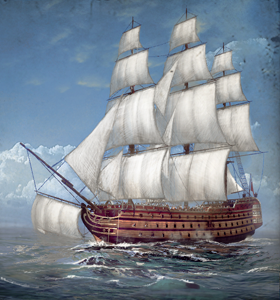Difference between revisions of "122-gun Ship of the Line (NTW Unit)"
(Created page with "{{Unit|image=File:122 ship of the line.png|Class=Over 1st Rate|Men=344|Guns=118|Recruitable From=Drydock|Region=Worldwide|Recruitment Cost=2890|Upkeep Cost=720|Technology Nee...") |
Tango12345 (talk | contribs) m (Quick-adding category "Napoleon Total War Units" (using HotCat)) |
||
| Line 5: | Line 5: | ||
Historically, ships as large and heavily protected as this over-sized first rate were incredibly expensive to maintain and required a large crew. They were often used as admiral’s flagships, as there was plenty of room for the admiral and his staff. The term flagship originates from the officers' custom of hanging distinctive pennants to denote their presence. These flags were often rather large: Lord Howe’s Union flag for use aboard his Royal Navy ship was 12-by-17 feet in size. | Historically, ships as large and heavily protected as this over-sized first rate were incredibly expensive to maintain and required a large crew. They were often used as admiral’s flagships, as there was plenty of room for the admiral and his staff. The term flagship originates from the officers' custom of hanging distinctive pennants to denote their presence. These flags were often rather large: Lord Howe’s Union flag for use aboard his Royal Navy ship was 12-by-17 feet in size. | ||
| + | |||
| + | [[Category:Napoleon Total War Units]] | ||
Revision as of 10:59, 13 August 2011
Overview
Like most large ships-of-the-line, this vessel is a terrifying sight for enemies and with good reason: its broadside is enormous. Each side of the ship, let alone the whole thing, has more guns than many land armies can boast! Such firepower, however, makes the ship heavy and cumbersome under sail. This is little comfort to those caught by its broadside. Equally, the price of the vessel and its high upkeep costs are little comfort to enemies either.
Historically, ships as large and heavily protected as this over-sized first rate were incredibly expensive to maintain and required a large crew. They were often used as admiral’s flagships, as there was plenty of room for the admiral and his staff. The term flagship originates from the officers' custom of hanging distinctive pennants to denote their presence. These flags were often rather large: Lord Howe’s Union flag for use aboard his Royal Navy ship was 12-by-17 feet in size.
